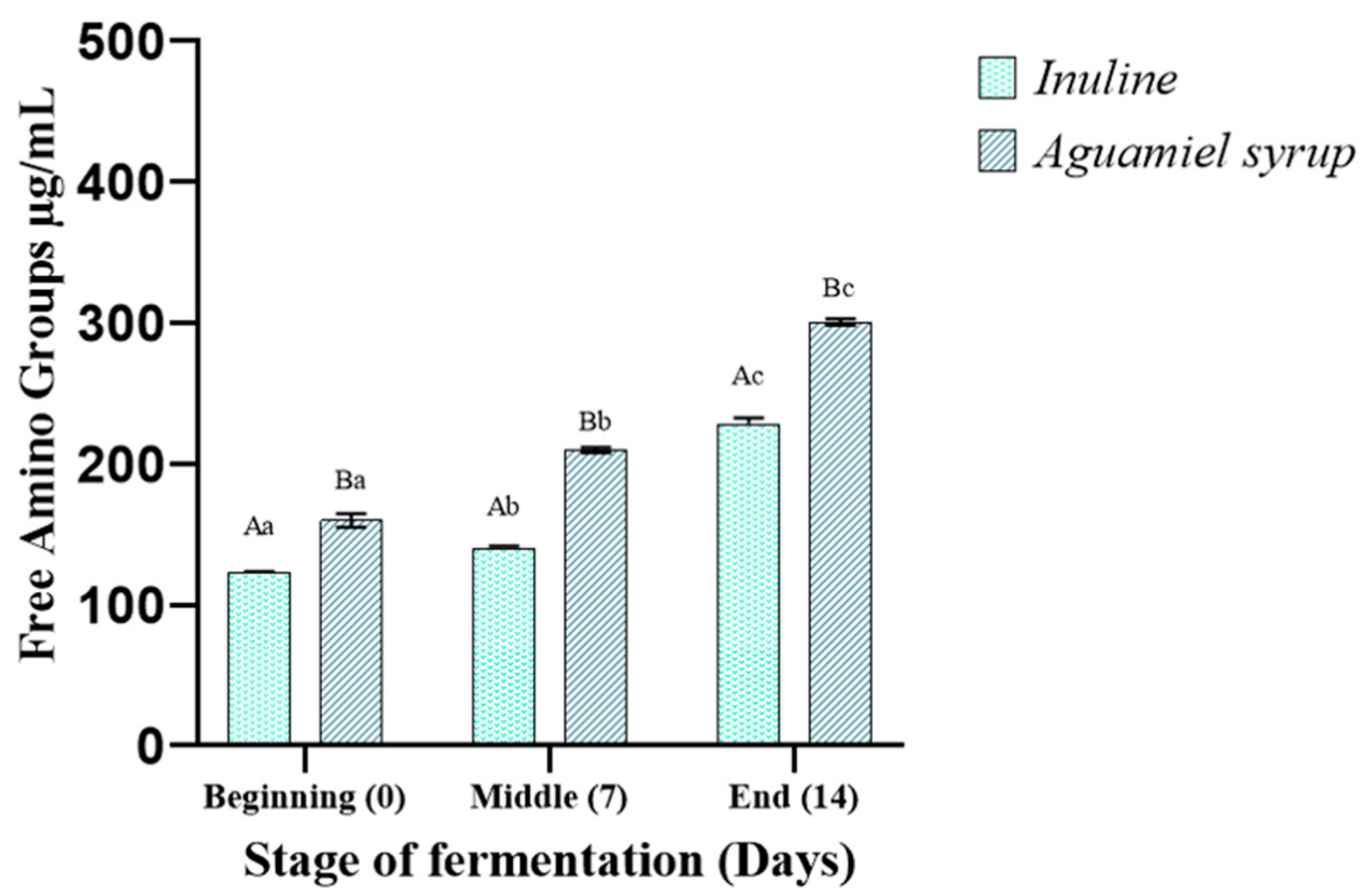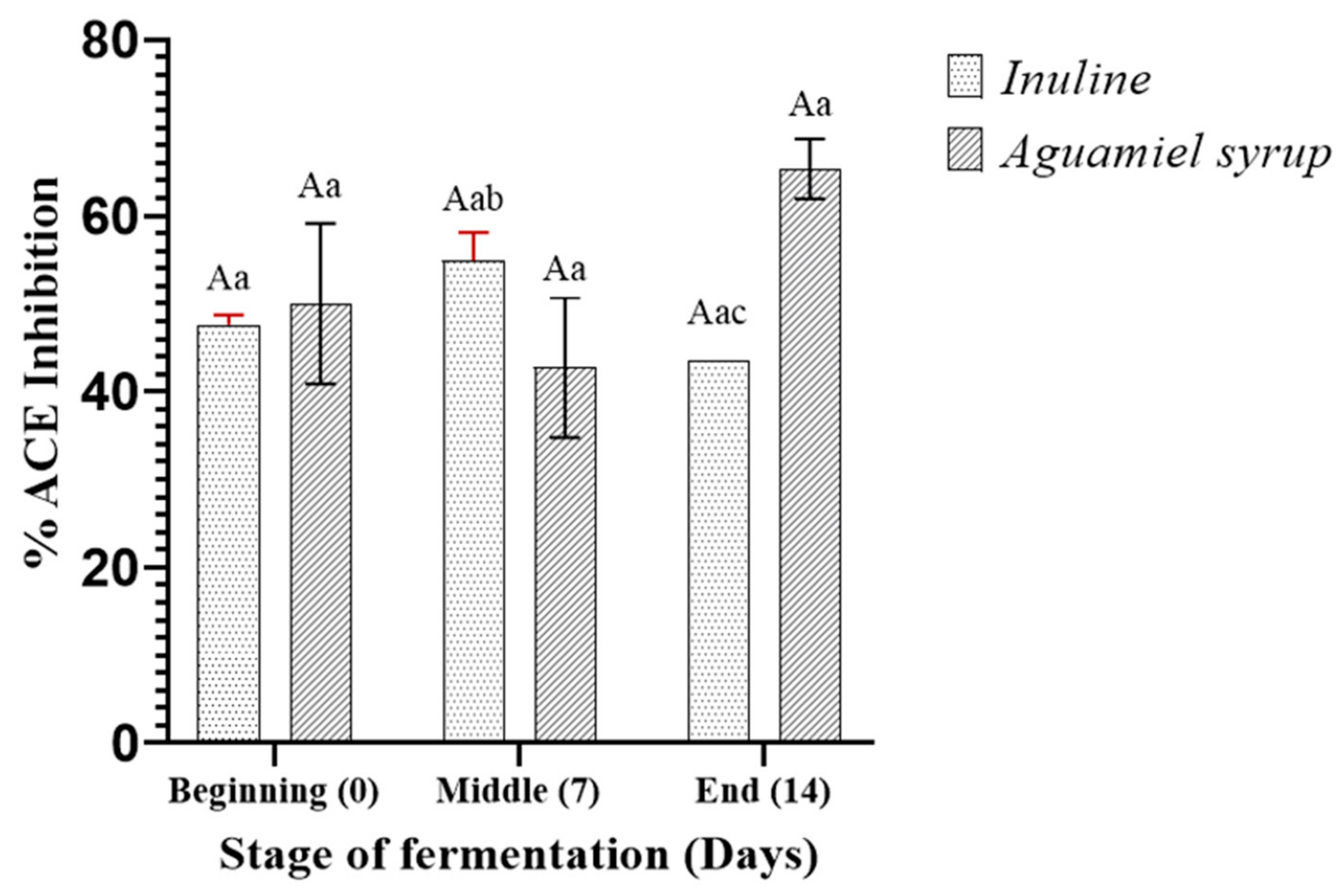Production of an Ice Cream Base with Added Lacticaseibacillus rhamnosus GG and Aguamiel Syrup: Probiotic Viability and Antihypertensive Capacity
Abstract
1. Introduction
2. Materials and Methods
2.1. Obtaining Aguamiel
2.2. Production of Aguamiel Syrup
2.3. Carbohydrate Characterization
2.4. Obtaining the Starter Culture
2.5. Preparation of Ice Cream Base
2.6. Growth of L. rhamnosus GG under Refrigeration Conditions
2.7. Determination of Overrun
2.8. Proteolytic Profile Analysis
2.8.1. Analysis of Free Amino Groups from the Ice Cream Base
2.8.2. Tris-Tricine Polyacrylamide Gel Electrophoresis (Tris-Tricine-SDS-PAGE)
2.9. ACE Inhibitory Activity
2.10. Statistical Analysis
3. Results and Discussion
3.1. Carbohydrates Present in Aguamiel and Aguamiel Syrup
3.2. Overrun, pH Changes, and Viability during Fermentation
3.3. Proteolytic Profile
3.3.1. TNBS Determination
3.3.2. Separation of Peptides by Tris-Tricine-SDS-PAGE
3.4. Antihypertensive Analysis: ACE Inhibition
4. Conclusions
Author Contributions
Funding
Institutional Review Board Statement
Informed Consent Statement
Data Availability Statement
Acknowledgments
Conflicts of Interest
References
- Villalva, F.J.; Cravero Bruneri, A.P.; Vinderola, G.; Gonçalvez De Oliveira, E.; Paz, N.F.; Ramón, A.N. Formulation of a Peach Ice Cream as Potential Symbiotic Food. Food Sci. Technol. 2017, 37, 456–461. [Google Scholar] [CrossRef]
- Kowalczyk, M.; Znamirowska-Piotrowska, A.; Buniowska-Olejnik, M.; Pawlos, M. Sheep Milk Symbiotic Ice Cream: Effect of Inulin and Apple Fiber on the Survival of Five Probiotic Bacterial Strains during Simulated In Vitro Digestion Conditions. Nutrients 2022, 14, 4454. [Google Scholar] [CrossRef] [PubMed]
- Aritonang, S.N.; Roza, E.; Rossi, E. The Effect of Whippy Cream Adding on the Quality of Frozen Soyghurt as Symbiotic Ice Cream. IOP Conf. Ser. Earth Environ. Sci. 2019, 287, 012029. [Google Scholar] [CrossRef]
- De Oliveira, A.P.D.; De Oliveira Almeida, T.J.; Santos, T.M.B.; Dias, F.S. Symbiotic Goat Milk Ice Cream with Umbu Fortified with Autochthonous Goat Cheese Lactic Acid Bacteria. LWT 2021, 141, 110888. [Google Scholar] [CrossRef]
- Olvera-Rosales, L.-B.; Cruz-Guerrero, A.-E.; Ramírez-Moreno, E.; Quintero-Lira, A.; Contreras-López, E.; Jaimez-Ordaz, J.; Castañeda-Ovando, A.; Añorve-Morga, J.; Calderón-Ramos, Z.-G.; Arias-Rico, J.; et al. Impact of the Gut Microbiota Balance on the Health–Disease Relationship: The Importance of Consuming Probiotics and Prebiotics. Foods 2021, 10, 1261. [Google Scholar] [CrossRef] [PubMed]
- El-Sayed, H.S.; Salama, H.H.; EL-Sayed, S.M. Production of Synbiotic Ice Cream. Int. J. Chemtech Res. 2014, 7, 138–147. [Google Scholar]
- Cheng, J.; Ma, Y.; Li, X.; Yan, T.; Cui, J. Effects of Milk Protein-Polysaccharide Interactions on the Stability of Ice Cream Mix Model Systems. Food Hydrocoll. 2015, 45, 327–336. [Google Scholar] [CrossRef]
- Jaimez-Ordaz, J.; Martínez-Ramírez, X.; Cruz-Guerrero, A.E.; Contreras-López, E.; Ayala-Niño, A.; Castro-Rosas, J.; González-Olivares, L.G. Survival and Proteolytic Capacity of Probiotics in a Fermented Milk Enriched with Agave Juice and Stored in Refrigeration. Food Sci. Technol. 2019, 39, 188–194. [Google Scholar] [CrossRef]
- Ramírez-Godínez, J.; Gutiérrez-Rodríguez, J.F.; Contreras-López, E.; Rodríguez-Serrano, G.M.; Castañeda-Ovando, A.; Jaimez-Ordaz, J.; González-Olivares, L.G. Agave Juice Improves Survival and Proteolytic Activity of Lactobacillus rhamnosus GG during Ripening of Semi-Ripened Mexican Cheese. Food Sci. Technol. 2022, 42, e30820. [Google Scholar] [CrossRef]
- Isabel Enríquez-Salazar, M.; Veana, F.; Aguilar, C.N.; De La Garza-Rodríguez, I.M.; López, M.G.; Rutiaga-Quiñones, O.M.; Morlett-Chávez, J.A.; Rodríguez-Herrera, R. Microbial Diversity and Biochemical Profile of Aguamiel Collected from Agave salmiana and A. atrovirens during Different Seasons of Year. Food Sci. Biotechnol. 2017, 26, 1003–1011. [Google Scholar] [CrossRef] [PubMed]
- Ortiz-Basurto, R.I.; Pourcelly, G.; Doco, T.; Williams, P.; Dornier, M.; Belleville, M.-P. Analysis of the Main Components of the Aguamiel Produced by the Maguey-Pulquero (Agave mapisaga) throughout the Harvest Period. J. Agric. Food Chem. 2008, 56, 3682–3687. [Google Scholar] [CrossRef]
- Castañeda-Ovando, A.; Moreno-Vilet, L.; Jaimez-Ordaz, J.; Ramírez-Godínez, J.; Pérez-Escalante, E.; Cruz-Guerrero, A.E.; Contreras-López, E.; Alatorre-Santamaría, S.A.; Guzmán-Rodríguez, F.J.; González-Olivares, L.G. Aguamiel Syrup as a Technological Diversification Product: Composition, Bioactivity and Present Panorama. Future Foods 2023, 8, 100249. [Google Scholar] [CrossRef]
- Cruz, A.G.; Antunes, A.E.C.; Sousa, A.L.O.P.; Faria, J.A.F.; Saad, S.M.I. Ice-Cream as a Probiotic Food Carrier. Food Res. Int. 2009, 42, 1233–1239. [Google Scholar] [CrossRef]
- Balthazar, C.F.; Silva, H.L.A.; Esmerino, E.A.; Rocha, R.S.; Moraes, J.; Carmo, M.A.V.; Azevedo, L.; Camps, I.; Abud, Y.K.D.; Sant’Anna, C.; et al. The Addition of Inulin and Lactobacillus casei 01 in Sheep Milk Ice Cream. Food Chem. 2018, 246, 464–472. [Google Scholar] [CrossRef]
- Moreno-Vilet, L.; Bostyn, S.; Flores-Montaño, J.-L.; Camacho-Ruiz, R.-M. Size-Exclusion Chromatography (HPLC-SEC) Technique Optimization by Simplex Method to Estimate Molecular Weight Distribution of Agave Fructans. Food Chem. 2017, 237, 833–840. [Google Scholar] [CrossRef]
- Olvera-Rosales, L.B.; Cruz-Guerrero, A.E.; García-Garibay, J.M.; Gómez-Ruíz, L.C.; Contreras-López, E.; Guzmán-Rodríguez, F.; González-Olivares, L.G. Bioactive Peptides of Whey: Obtaining, Activity, Mechanism of Action, and Further Applications. Crit. Rev. Food Sci. Nutr. 2023, 63, 10351–10381. [Google Scholar] [CrossRef]
- Schägger, H.; Von Jagow, G. Tricine-Sodium Dodecyl Sulfate-Polyacrylamide Gel Electrophoresis for the Separation of Proteins in the Range from 1 to 100 kDa. Anal. Biochem. 1987, 166, 368–379. [Google Scholar] [CrossRef]
- González-Olivares, L.G.; Añorve-Morga, J.; Castañeda-Ovando, A.; Contreras-López, E.; Jaimez-Ordaz, J. Peptide Separation of Commercial Fermented Milk during Refrigerated Storage. Food Sci. Technol. 2014, 34, 674–679. [Google Scholar] [CrossRef]
- Cushman, D.W.; Wang, F.L.; Fung, W.C.; Harvey, C.M.; DeForrest, J.M. Differentiation of Angiotensin–Converting Enzyme (ACE) Inhibitors by Their SelectiveInhibition of ACE in Physiologically Important Target Organs. Am. J. Hypertens. 1989, 2, 294–306. [Google Scholar] [CrossRef] [PubMed]
- Peralta-García, I.; González-Muñoz, F.; Elena, R.-A.M.; Sánchez-Flores, A.; López Munguía, A. Evolution of Fructans in Aguamiel (Agave Sap) During the Plant Production Lifetime. Front. Nutr. 2020, 7, 566950. [Google Scholar] [CrossRef]
- Romero-López, M.R.; Osorio-Díaz, P.; Flores-Morales, A.; Robledo, N.; Mora-Escobedo, R. Chemical Composition, Antioxidant Capacity and Prebiotic Effect of Aguamiel (Agave atrovirens) during in Vitro Fermentation. Rev. Mex. Ing. Química 2015, 14, 281–292. [Google Scholar]
- Villarreal-Morales, S.L.; Muñiz-Márquez, D.B.; Michel-Michel, M.; González-Montemayor, Á.-M.; Escobedo-García, S.; Salas-Tovar, J.A.; Flores-Gallegos, A.C.; Rodríguez-Herrera, R. Aguamiel a Fresh Beverage from Agave spp. Sap with Functional Properties. In Natural Beverages; Elsevier: Amsterdam, The Netherlands, 2019; pp. 179–208. ISBN 978-0-12-816689-5. [Google Scholar]
- Kolida, S.; Tuohy, K.; Gibson, G.R. Prebiotic Effects of Inulin and Oligofructose. Br. J. Nutr. 2002, 87, S193–S197. [Google Scholar] [CrossRef] [PubMed]
- González-Cruz, L.; Jaramillo-Flores, M.E.; Bernardino-Nicanor, A.; Mora-Escobedo, R. Influence of the Harvest Age on Fructan Content and Fructosyltransferase Activity in Agave atrovirens Karw Pine. Int. J. Plant Physiol. Biochem. 2012, 4, 110–119. [Google Scholar] [CrossRef]
- Akalın, A.S.; Erişir, D. Effects of Inulin and Oligofructose on the Rheological Characteristics and Probiotic Culture Survival in Low-Fat Probiotic Ice Cream. J. Food Sci. 2008, 73, M184–M188. [Google Scholar] [CrossRef] [PubMed]
- Olvera-Rosales, L.B.; Pérez-Escalante, E.; Castañeda-Ovando, A.; Contreras-López, E.; Cruz-Guerrero, A.E.; Regal-López, P.; Cardelle-Cobas, A.; González-Olivares, L.G. ACE-Inhibitory Activity of Whey Proteins Fractions Derived of Fermentation by Lacticaseibacillus rhamnosus GG and Streptococcus thermophilus SY-102. Foods 2023, 12, 2416. [Google Scholar] [CrossRef]
- Silva, P.D.L.D.; Bezerra, M.D.F.; Santos, K.M.O.D.; Correia, R.T.P. Potentially Probiotic Ice Cream from Goat’s Milk: Characterization and Cell Viability during Processing, Storage and Simulated Gastrointestinal Conditions. LWT-Food Sci. Technol. 2015, 62, 452–457. [Google Scholar] [CrossRef]
- Dos Santos Cruxen, C.E.; Hoffmann, J.F.; Zandoná, G.P.; Fiorentini, Â.M.; Rombaldi, C.V.; Chaves, F.C. Probiotic Butiá (Butia odorata) Ice Cream: Development, Characterization, Stability of Bioactive Compounds, and Viability of Bifidobacterium lactis during Storage. LWT 2017, 75, 379–385. [Google Scholar] [CrossRef]
- Sun, J.; Chen, H.; Qiao, Y.; Liu, G.; Leng, C.; Zhang, Y.; Lv, X.; Feng, Z. The Nutrient Requirements of Lactobacillus rhamnosus GG and Their Application to Fermented Milk. J. Dairy. Sci. 2019, 102, 5971–5978. [Google Scholar] [CrossRef] [PubMed]
- Sebastián-Nicolas, J.L.; Contreras-López, E.; Ramírez-Godínez, J.; Cruz-Guerrero, A.E.; Rodríguez-Serrano, G.M.; Añorve-Morga, J.; Jaimez-Ordaz, J.; Castañeda-Ovando, A.; Pérez-Escalante, E.; Ayala-Niño, A.; et al. Milk Fermentation by Lacticaseibacillus rhamnosus GG and Streptococcus thermophilus SY-102: Proteolytic Profile and ACE-Inhibitory Activity. Fermentation 2021, 7, 215. [Google Scholar] [CrossRef]
- Laakso, K.; Koskenniemi, K.; Koponen, J.; Kankainen, M.; Surakka, A.; Salusjärvi, T.; Auvinen, P.; Savijoki, K.; Nyman, T.A.; Kalkkinen, N.; et al. Growth Phase-associated Changes in the Proteome and Transcriptome of Lactobacillus rhamnosus GG in Industrial-type Whey Medium. Microb. Biotechnol. 2011, 4, 746–766. [Google Scholar] [CrossRef]
- Hafeez, Z.; Cakir-Kiefer, C.; Lecomte, X.; Miclo, L.; Dary-Mourot, A. The X-Prolyl Dipeptidyl-Peptidase PepX of Streptococcus thermophilus Initially Described as Intracellular Is Also Responsible for Peptidase Extracellular Activity. J. Dairy. Sci. 2019, 102, 113–123. [Google Scholar] [CrossRef]
- González-Olivares, L.G.; Jiménez-Guzmán, J.; Cruz-Guerrero, A.; Rodríguez-Serrano, G.; Gómez-Ruiz, L.; García-Garibay, M. Bioactive Peptides Released by Lactic Acid Bacteria in Commercial Fermented Milks. Rev. Mex. Ing. Química 2011, 10, 179–188. [Google Scholar]
- Quirós, A.; Ramos, M.; Muguerza, B.; Delgado, M.A.; Miguel, M.; Aleixandre, A.; Recio, I. Identification of Novel Antihypertensive Peptides in Milk Fermented with Enterococcus faecalis. Int. Dairy J. 2007, 17, 33–41. [Google Scholar] [CrossRef]
- Ali, E.; Nielsen, S.D.; Abd-El Aal, S.; El-Leboudy, A.; Saleh, E.; LaPointe, G. Use of Mass Spectrometry to Profile Peptides in Whey Protein Isolate Medium Fermented by Lactobacillus helveticus LH-2 and Lactobacillus Acidophilus La-5. Front. Nutr. 2019, 6, 152. [Google Scholar] [CrossRef] [PubMed]
- Olvera-Rosales, L.B.; Cruz-Guerrero, A.E.; Jaimez-Ordaz, J.; Pérez-Escalante, E.; Quintero-Lira, A.; Ramírez-Moreno, E.; Contreras-López, E.; González-Olivares, L.G. Differences in the Proteolytic System of Lactic Acid Bacteria Affect the Release of DPP-IV Inhibitory Peptides from Whey Proteins. Dairy 2023, 4, 515–526. [Google Scholar] [CrossRef]
- Innocente, N.; Biasutti, M.; Rita, F.; Brichese, R.; Comi, G.; Iacumin, L. Effect of Indigenous Lactobacillus rhamnosus Isolated from Bovine Milk on Microbiological Characteristics and Aromatic Profile of Traditional Yogurt. LWT-Food Sci. Technol. 2016, 66, 158–164. [Google Scholar] [CrossRef]
- Murray, B.; FitzGerald, R. Angiotensin Converting Enzyme Inhibitory Peptides Derived from Food Proteins: Biochemistry, Bioactivity and Production. CPD 2007, 13, 773–791. [Google Scholar] [CrossRef]
- Yu, Y.; Yu, W.; Jin, Y. Peptidomic Analysis of Milk Fermented by Lactobacillus delbrueckii Subsp. bulgaricus and Streptococcus thermophilus. Food Hydrocoll. Health 2021, 1, 100033. [Google Scholar] [CrossRef]
- Li, G.; Le, G.; Shi, Y.; Shrestha, S. Angiotensin I–Converting Enzyme Inhibitory Peptides Derived from Food Proteins and Their Physiological and Pharmacological Effects. Nutr. Res. 2004, 24, 469–486. [Google Scholar] [CrossRef]




| Aguamiel | Aguamiel Syrup | |
|---|---|---|
| Compound | Concentration (mg/mL) | Concentration (mg/g) |
| Monosaccharide | 23.76 | 168.05 |
| Disaccharide | 52.16 | 345.74 |
| Trisaccharide | 1.41 | 9.08 |
| Oligosaccharide | 7.91 | 55.19 |
| Time (Days) | Overrun (%) | pH | Viability (CFU/mL) | |||
|---|---|---|---|---|---|---|
| I | AS | I | AS | I | AS | |
| 0 | 47.26 | 6.48 | 5.78 | 6.37 | 8.48 ± 0.01 | 8.48 ± 0.19 |
| 7 | 49.73 | 9.84 | 5.58 | 5.15 | 8.48 ± 0.13 | 8.48 ± 0.03 |
| 14 | 49.73 | 5.55 | 5.57 | 5.00 | 8.46 ± 0.10 | 8.45 ± 0.13 |
Disclaimer/Publisher’s Note: The statements, opinions and data contained in all publications are solely those of the individual author(s) and contributor(s) and not of MDPI and/or the editor(s). MDPI and/or the editor(s) disclaim responsibility for any injury to people or property resulting from any ideas, methods, instructions or products referred to in the content. |
© 2024 by the authors. Licensee MDPI, Basel, Switzerland. This article is an open access article distributed under the terms and conditions of the Creative Commons Attribution (CC BY) license (https://creativecommons.org/licenses/by/4.0/).
Share and Cite
Hernández-Riveros, E.; Olvera-Rosales, L.B.; Jaimez-Ordaz, J.; Pérez-Escalante, E.; Contreras-López, E.; Cruz-Guerrero, A.E.; González-Olivares, L.G. Production of an Ice Cream Base with Added Lacticaseibacillus rhamnosus GG and Aguamiel Syrup: Probiotic Viability and Antihypertensive Capacity. Dairy 2024, 5, 451-463. https://doi.org/10.3390/dairy5030035
Hernández-Riveros E, Olvera-Rosales LB, Jaimez-Ordaz J, Pérez-Escalante E, Contreras-López E, Cruz-Guerrero AE, González-Olivares LG. Production of an Ice Cream Base with Added Lacticaseibacillus rhamnosus GG and Aguamiel Syrup: Probiotic Viability and Antihypertensive Capacity. Dairy. 2024; 5(3):451-463. https://doi.org/10.3390/dairy5030035
Chicago/Turabian StyleHernández-Riveros, Edward, Laura Berenice Olvera-Rosales, Judith Jaimez-Ordaz, Emmanuel Pérez-Escalante, Elizabeth Contreras-López, Alma Elizabeth Cruz-Guerrero, and Luis Guillermo González-Olivares. 2024. "Production of an Ice Cream Base with Added Lacticaseibacillus rhamnosus GG and Aguamiel Syrup: Probiotic Viability and Antihypertensive Capacity" Dairy 5, no. 3: 451-463. https://doi.org/10.3390/dairy5030035
APA StyleHernández-Riveros, E., Olvera-Rosales, L. B., Jaimez-Ordaz, J., Pérez-Escalante, E., Contreras-López, E., Cruz-Guerrero, A. E., & González-Olivares, L. G. (2024). Production of an Ice Cream Base with Added Lacticaseibacillus rhamnosus GG and Aguamiel Syrup: Probiotic Viability and Antihypertensive Capacity. Dairy, 5(3), 451-463. https://doi.org/10.3390/dairy5030035








